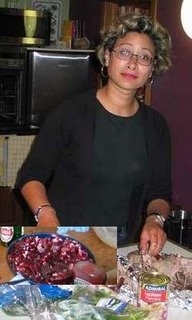
In the wake of ever increasing requests for the finer details of the famous beetroot & feta salad that makes an appearance at every Pyrland Road party, herewith is reproduced the recipe: (c) & (tm) Mary Massina.
Buy either small beetroot or large bulbs (in UK, buy those little beauties pre-cooked in the bag - ed) - think its at least half of a large per person. Cut into quarters, don't peel, and oven roast at 180 until soft but not mushy - could take at least 30 - 45 minutes.
Cool and then, wearing gloves, peel - the skin should come away when rubbed.
Cut into small bits into a bowl.
Then add finely diced red onion and oven roasted capiscum - which you can buy in a deli but if not I tell you how do it later!
Mix up a dressing of balsmic vinger and olive oil and 1/2 of sugar.
Mix through and let stand - the longer the better
Then crumble feta on top and when ready to serve mix through - carefully! and don't forget to add another lot of feta on top for looks!
Oven roasted caps - put a whole capiscum into the oven and cook, probably at the same time as the beetroot until the skin starts turning brown - take out and put in a plastic bag to sweat - that way the skin is easy to peel. Or buy a jar of them at your local Turkish shop - ed
Peel and discard the seeds and the "pith" cut into strips.
You can also do this over the gas - buy turning the capiscum once the skin is charred. and then peel as above.
Don't forget if you have any left over caps cover them in olive oil - that way they keep for ever!!!









